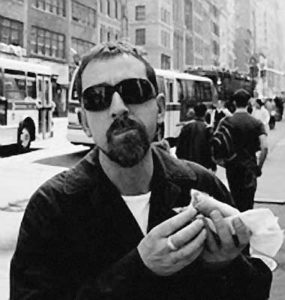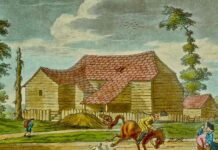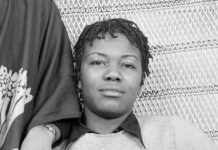Nick Buglione continues a journey through time with his recollections of Brixton – this month, the noughties
 Sooner or later, we grow up and cast aside our youthful indulgences. And have babies, careers and mortgages. And in my case, take a sabbatical from Brixton. Yes, while the new millennium arrived in a rented house in still murky Loughborough Junction, I soon temporarily disembarked the good ship SW2 and (luckily, through a housing association) bought (half) a house in the slightly leafier East Dulwich (née Peckham). Back in the days when someone other than the Candy brothers could buy London property. Where, instead of what party or gig to go to, life became all Pampers, sleepless nights, Calpol and nursery places.
Sooner or later, we grow up and cast aside our youthful indulgences. And have babies, careers and mortgages. And in my case, take a sabbatical from Brixton. Yes, while the new millennium arrived in a rented house in still murky Loughborough Junction, I soon temporarily disembarked the good ship SW2 and (luckily, through a housing association) bought (half) a house in the slightly leafier East Dulwich (née Peckham). Back in the days when someone other than the Candy brothers could buy London property. Where, instead of what party or gig to go to, life became all Pampers, sleepless nights, Calpol and nursery places.
By the mid 2000s, with Lordship Lane rapidly morphing into a cut-price Northcote Road full of Petit Bateau, White Stuff, upscale delis, bugaboos, lattes and private schooling plans, I came home. While Brixton took arguably its biggest steps on the yellow brick road to today’s aspirational urban pleasure ground.
I still worked here, freelancing in a crazy, crumbling, often unheated Fridge-owned tenement on Porden Road. And working for The Fridge. Myself, fellow Brixtonian journo, Kate Burt and a motley crew of designers, record label lads and creatives were supposed to turn our old clubbing ground into a live music venue. Ironically, Electric Brixton is now exactly that. I suspect we were about 10 years too early. Apart from a few events and over-expensive rebranding, the Fridge’s somewhat mercurial system of actually paying us meant we were only a temporary waystation on the road to its eventual demise in 2010. Though we did have some great nights hosting sweaty, smoky live sessions in the basement of the Fridge Bar, hiring Rob Da Bank (now of Bestival superstardom) and Faithless’ Maxi Jazz to man our decks. Slightly bizarre mezzanine evenings with scruffy indie kids on the beer downstairs and “Return of the Mack” ultra–bling Cadillac kings buying Cristal upstairs.
Meanwhile, Brian Paddick came and (unfortunately) went as Lambeth’s head honcho policeman, taking his enlightened, progressive but ultimately rejected policies on the lesser classes of drug possession with him. Francos became the now ubiquitous sourdough empire Franca Manca and our mostly derelict art-deco covered market began to transform into the “Village”. The George Canning became the Hobgoblin became Hootananny. Another marvellously misfit day was the World Cup 2004, Italy v Republic of Ireland where the pub’s TV hall was packed to the ceiling with a riotous combo of drunken Irish football fans and hordes of flamboyant super-camp Grayson Perry-esque revellers from that day’s Pride.
Much like, for example, New York’s lower East side, Brixton has run the full gauntlet of regeneration. Cheap and cheerful attracts bohemians and creatives. The area gets a cachet. Bars and restaurants open and the area becomes desirable as a (slightly) edgy place to live. Estate agents smell their prey and house prices rev up towards today’s salary busting levels.
The gentrification jury is still out on whether this has been a modern urban regeneration success story, a travesty of social exclusion, or something in between.
What definitely happened was we had a deluge of pop-up, start-up dining spots and Brixton became a destination for all the Londoners who a few years before would never have thought of descending down the Victoria Line to visit us.
These were the honeymoon years when the alliance of Spacemakers, property developers and Lambeth council created what our resident food aficionado Jay Rayner called “the most exciting, radical venture on the British restaurant scene” The rent hikes, terminated local traders, Brindisa, Wahaca and lazy ironic reinvention pop-ups were still a way off.
 All this was fuelled in no small part by the arrival of smartphones and social media. Not only can Facebook now remember it for you wholesale, and you essentially can run a business or career from your palm, everyone from Honest Burger to Federation Coffee to your very own Bugle founders Zoe Jewell and Tim Dickens mobilised Twitter and Co to drive word-of-mouth marketing. Marketing by finger stroke on an iPhone and you can’t sell artisan burgers unless you have a legion of Twitter customers (and a queue).
All this was fuelled in no small part by the arrival of smartphones and social media. Not only can Facebook now remember it for you wholesale, and you essentially can run a business or career from your palm, everyone from Honest Burger to Federation Coffee to your very own Bugle founders Zoe Jewell and Tim Dickens mobilised Twitter and Co to drive word-of-mouth marketing. Marketing by finger stroke on an iPhone and you can’t sell artisan burgers unless you have a legion of Twitter customers (and a queue).
So, post Peckham sabbatical, I returned to Brixton to find that the squats we once colonised on Saturday nights were all being done up, split into flats and sold for new interplanetary prices and my neighbours all seemed to be late twenty-something, early thirty-something public schoolers.
And therein you have modern Brixton in a nutshell. We are (thankfully) not Clapham; we’re not completely Shoreditch-ified.
Somehow, despite the debate about social cleansing, the homogenisation of the high road and the seemingly limitless popularity of our patch for everyone from Lands End to John o’Groats, Brixton still retains a messy, slightly scuzzy familiarity. It still isn’t everywhere else, and while I don’t buy the more hysterical end of the gentrification debate, it’s a few thousand miles from the Brixton I grew up in.
Now I am more bothered by school entrance criteria than who is DJ-ing at The Dogstar. By the noughties, Brixton, like me, had grown up. Growing pains, as it turns out, were inevitable.






